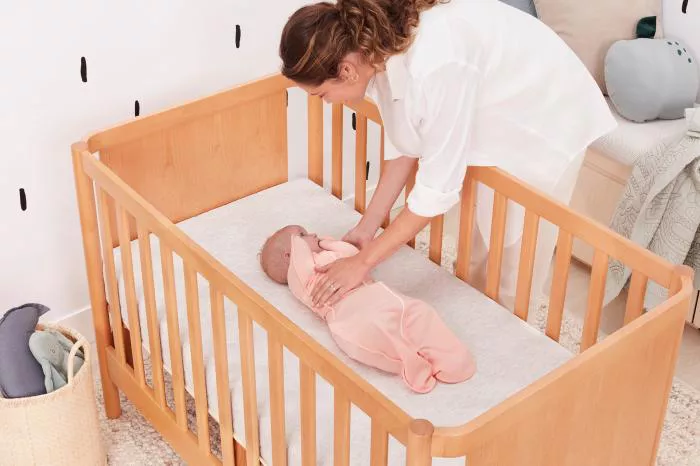Ensuring that newborns sleep safely and comfortably is a top priority for new parents. From choosing the right sleeping position to understanding safe sleep practices, parents must navigate several important considerations to promote their baby’s well-being. In this article, we’ll explore the recommended sleeping positions for newborns, the reasons behind these recommendations, and practical tips for creating a safe sleep environment.
Recommended Sleeping Position for Newborns
The American Academy of Pediatrics (AAP) provides clear guidelines on how newborns should lay during sleep to reduce the risk of Sudden Infant Death Syndrome (SIDS) and ensure overall safety. The primary recommendation is that babies should always be placed on their backs to sleep.
Why Back Sleeping is Essential
Reduced Risk of SIDS: Placing a newborn on their back for every sleep reduces the risk of SIDS. SIDS is the sudden and unexplained death of an otherwise healthy infant, often occurring during sleep. Research has shown that babies who sleep on their stomachs or sides are at a higher risk of SIDS compared to those who sleep on their backs.
Airway Safety: Sleeping on the back keeps the baby’s airway open and reduces the risk of suffocation. When a baby sleeps on their stomach or side, there is a greater chance that their face could press against bedding or other surfaces, which can obstruct breathing.
Promotes Healthy Development: Back sleeping supports optimal physical development. It prevents positional plagiocephaly, also known as flat head syndrome, where the back of the head becomes flattened from lying in one position for too long. Alternating the baby’s head position while they are awake can also help prevent this condition.
Safe Sleep Environment
Creating a safe sleep environment is just as important as choosing the right sleeping position. Here are key tips to ensure your newborn’s sleep space is safe:
Use a Firm Mattress: Place your baby on a firm, flat mattress in a safety-approved crib, bassinet, or portable play yard. Soft bedding, pillows, or stuffed animals should be kept out of the sleep area to avoid potential suffocation hazards.
Keep the Sleep Area Clear: Ensure that the crib or bassinet is free of loose bedding, bumper pads, and toys. The sleep surface should be uncluttered to minimize the risk of accidental suffocation.
Use a Sleep Sack: Instead of loose blankets, use a sleep sack or wearable blanket to keep your baby warm. These garments are designed to provide warmth while keeping the sleep area free of loose bedding.
Room Sharing: The AAP recommends that parents room-share with their baby for at least the first six months but avoid bed-sharing. Room-sharing means placing the baby’s crib or bassinet in the same room as the parents’ bed, making it easier for parents to attend to their baby during the night.
When to Change Sleep Positions
While back sleeping is the safest position for newborns, there are times when changes may be necessary:
Tummy Time: While babies should sleep on their backs, they should also have supervised tummy time while awake. Tummy time helps strengthen the baby’s neck, shoulders, and arms, promoting motor skills and preventing developmental delays. Start with a few minutes a day and gradually increase the time as your baby grows.
Rolling Over: As babies grow and develop, they will begin to roll over on their own. Once your baby is consistently rolling over from back to front and vice versa, it is safe to allow them to choose their own sleep position. However, always start sleep time with the baby on their back.
Addressing Sleep Concerns
Some parents may have concerns about their baby’s sleep patterns or safety. Here are common concerns and tips for addressing them:
Baby’s Resistance to Back Sleeping: If your baby resists sleeping on their back, ensure that the sleep environment is comfortable and soothing. Try swaddling your baby, using white noise, or establishing a consistent bedtime routine to help them feel secure and relaxed.
Sleep Position Monitors: Some parents use sleep position monitors to keep track of their baby’s sleep position. While these devices can provide peace of mind, they should not replace safe sleep practices. Always place your baby on their back for every sleep and maintain a safe sleep environment.
Consulting a Pediatrician: If you have concerns about your baby’s sleep patterns, health, or development, consult your pediatrician. They can provide personalized advice and address any specific issues you may have.
Creating a Safe Sleep Routine
Establishing a consistent sleep routine can help your newborn develop healthy sleep habits. Here are some tips for creating a safe and effective sleep routine:
Establish a Bedtime Routine: Create a calming bedtime routine to signal to your baby that it’s time to sleep. This may include activities such as bathing, reading a short story, or gentle rocking. A consistent routine helps your baby transition smoothly from wakefulness to sleep.
Maintain a Consistent Sleep Schedule: Try to put your baby to sleep and wake them up at the same times each day. Consistency helps regulate their internal clock and promotes better sleep patterns.
Monitor Sleep Environment: Ensure that the sleep environment remains consistent and conducive to rest. Keep the room at a comfortable temperature, use a nightlight if needed, and maintain a quiet atmosphere during sleep times.
See also: How Long Until a Newborn Can Sleep Through the Night?
Summary: Prioritizing Safe Sleep for Your Newborn
In summary, placing your newborn on their back to sleep is the most important step in ensuring their safety and reducing the risk of SIDS. Creating a safe sleep environment, maintaining a consistent sleep routine, and addressing any concerns with your pediatrician are key to promoting healthy sleep habits.
By following these guidelines and prioritizing your baby’s sleep safety, you can help ensure that they get the rest they need to grow and thrive. As always, if you have any questions or concerns about your baby’s sleep, don’t hesitate to reach out to a healthcare professional for personalized guidance and support.


